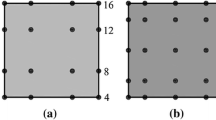Abstract
This study develops a frequency-domain method for modelling general transient linear-elastic dynamic problems using the semi-analytical scaled boundary finite element method (SBFEM). This approach first uses the newly-developed analytical Frobenius solution to the governing equilibrium equation system in the frequency domain to calculate complex frequency-response functions (CFRFs). This is followed by a fast Fourier transform (FFT) of the transient load and a subsequent inverse FFT of the CFRFs to obtain time histories of structural responses. A set of wave propagation and structural dynamics problems, subjected to various load forms such as Heaviside step load, triangular blast load and ramped wind load, are modelled using the new approach. Due to the semi-analytical nature of the SBFEM, each problem is successfully modelled using a very small number of degrees of freedom. The numerical results agree very well with the analytical solutions and the results from detailed finite element analyses.
Similar content being viewed by others
References
Zienkiewicz OC, Taylor RL (2000) The finite element method. 5th edn. Butterworth–Heinemann, London
Dokainish MA, Subbaraj K (1989) A survey of direct time-integration methods in computational structural dynamics—I. Explicit methods. Comput Struct 32(6):13711–1386
Subbaraj K, Dokainish MA (1989) A survey of direct time-integration methods in computational structural dynamics—II. Implicit methods. Comput Struct 32(6):1387–1401
Murti V, Valliappan S (1986) The use of quarter point element in dynamic crack analysis. Eng Fract Mech 23(3):585–614
Wiberg NE, Zeng LF, Li XD (1992) Error estimation and mesh adaptivity for elastodynamics. Comput Methods Appl Mech Eng 101:369–395
Zeng LF, Wiberg NE (1992) Spatial mesh adaptation in semidiscrete finite element analysis of linear elastodynamics problems. Comput Mech 9:315–332
Carrer JAM, Mansur WJ (2004) Alternative time-marching schemes for elastodynamic analysis with the domain boundary element method formulation. Comput Mech 34(5):387–399
Carrer JAM, Mansur WJ (2000) Time discontinuous linear traction approximation in time-domain BEM: 2-D elastodynamics. Int J Numer Methods Eng 49(6):833–848
Wang CC, Wang HC, Liou GS (1997) Quadratic time domain BEM formulation for 2D elastodynamic transient analysis. Int J Solids Struct 34(1):129–151
Tanaka M, Chen W (2001) Dual reciprocity BEM applied to transient elastodynamic problems with differential quadrature method in time. Comput Methods Appl Mech Eng 190(18–19):2331–2347
Yu GY, Mansur WJ, Carrer JAM (2001) A more stable scheme for BEM/FEM coupling applied to two-dimensional elastodynamics. Comput Struct 79(8):811–823
Chien CC, Wu TY (2001) A particular integral BEM/time-discontinuous FEM methodology for solving 2-D elastodynamic problems. Int J Solids Struct 38(2):289–306
Sladek J, Sladek V, Van Keer R (2003) Meshless local boundary integral equation method for 2D elastodynamic problems. Int J Numer Methods Eng 57(2):235–249
Gu YT, Liu GR (2001) A meshless local Petrov–Galerkin (MLPG) method for free and forced vibration analyses for solids. Comput Mech 27: 188–198
Batra RC, Porfiri M, Spinello D (2006) Free and forced vibrations of a segmented bar by a meshless local Petrov–Galerkin (MLPG) formulation. Comput Mech published online. DOI: 10.1007/s00466-006-0049-6
Wolf JP, Song CM (1996) Finite-element modelling of unbounded media. Wiley Chichester
Wolf JP (2003) The scaled boundary finite element method. Wiley Chichester
Zhang X, Wegner JL, Haddow JB (1999) Three-dimensional dynamic soil-structure interaction analysis in the time domain. Earthquake Eng Struct Dyn 28(12):1501–1524
Yan JY, Zhang CH, Jin F (2004) A coupling procedure of FE and SBFE for soil-structure interaction in the time domain. Int J Numer Methods Eng 59(11):1453–1471
Ekevid T, Wiberg NE (2002) Wave propagation related to high-speed train - a scaled boundary FE-approach for unbounded domains. Comput Methods Appl Mech Eng 191(36):3947–3964
Genes MC, Kocak S (2005) Dynamic soil-structure interaction analysis of layered unbounded media via a coupled element/boundary element/scaled boundary finite element model. Int J Numer Methods Eng 62(6):798–823
Song CM (2004) A super-element for crack analysis in the time domain. Int J Numer Methods Eng 61(8):1332–1357
Spyrakos CC, Beskos DE (1982) Dynamic response of frameworks by fast Fourier transform. Comput Struct 15(5): 495–505
Polyzos D, Tsepoura KG, Beskos DE (2005) Transient dynamic analysis of 3-D gradient elastic solids by BEM. Comput Struct 83(10–11):783–792
Song CM, Wolf JP (1998) The scaled boundary finite-element method: analytical solution in frequency domain. Comput Methods Appl Mech Eng 164(1–2):249–264
Yang ZJ, Deeks AJ, Hao H (2006) A Frobenius solution to the scaled boundary finite element equations in frequency domain. Int J Numer Methods Eng (in press). DOI 10.1002/nme.1926
Yang ZJ (2006) Fully automatic modelling of mixed-mode crack propagation using scaled boundary finite element method. Eng Fracture Mech (in press) 73(12):1711–1731
Deeks AJ (2004) Prescribed side-face displacements in the scaled boundary finite-element method. Comput Struct 82(15–16):1153–1165
Deeks AJ, Wolf JP (2002) A virtual work derivation of the scaled boundary finite-element method for elastostatics. Comput Mech 28(6):489–504
Cooley JW, Tukey JW (1965) An algorithm for the machine calculation of complex Fourier series. Math Comput 19:297–301
MATLAB V7.1. The MathWorks, Inc, 2005
Hibbitt, Karlsson and Sorensen Inc. ABAQUS/Standard User Manual V6.5, 2004
Timoshenko S, Young DH, Weaver W (1974) Vibration problems in engineering 4th edn. Wiley, New York
Zienkiewicz OC, Li XK, Nakazawa S (1986) Dynamic transient analysis by a mixed, iterative method. Int J Numer Methods Eng 23(7):1343–1353
Chung J, Hulbert GM (1993) A time integration algorithm for structural dynamics with improved numerical dissipation: the generalized-alpha method. J Appl Mech-Trans ASME 60:371–375
Author information
Authors and Affiliations
Corresponding author
Rights and permissions
About this article
Cite this article
Yang, Z.J., Deeks, A.J. A frequency-domain approach for modelling transient elastodynamics using scaled boundary finite element method. Comput Mech 40, 725–738 (2007). https://doi.org/10.1007/s00466-006-0135-9
Received:
Accepted:
Published:
Issue Date:
DOI: https://doi.org/10.1007/s00466-006-0135-9




